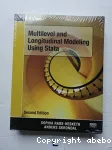 Accueil
Accueil
| Titre : | Multilevel and longitudinal modeling using Stata |
| Auteurs : | Sophia Rabe-Hesketh ; Anders Skrondal |
| Type de document : | texte imprimé |
| Mention d'édition : | 2nd ed. |
| Editeur : | College Station [USA] : Stata Press, 2008 |
| ISBN/ISSN/EAN : | 978-1-59718-040-5 |
| Format : | 562 p. |
| Langues: | Anglais |
| Catégories : |
Thésaurus CEREQ MODELISATION ; ECONOMETRIE ; STATISTIQUE |
| Résumé : | Multilevel and Longitudinal Modeling Using Stata, Second Edition discusses regression modeling of clustered or hierarchical data, such as data on students nested in schools, patients in hospitals, or employees in firms. Longitudinal data are also clustered with, for instance, repeated measurements on patients or several panel waves per survey respondent. Multilevel and longitudinal modeling can exploit the richness of such data and can disentangle processes operating at different levels. Assuming some knowledge of linear regression, this bestseller explains models and their assumptions, applies methods to real data using Stata, and shows how to interpret the results. The applications and exercises span a wide range of disciplines, making the book suitable for courses on multilevel and longitudinal modeling in the medical, social, and behavioral sciences and in applied statistics. This extensively revised second edition includes 3 new chapters, comprehensive updates for Stata 10, 38 new exercises, and 27 new data sets. The authors teach multilevel and longitudinal modeling at their universities and frequently hold workshops at international conferences. They have been developing a general modeling framework, GLLAMM, and Stata software gllamm for multilevel and latent variable modeling. This work has been published in their highly acclaimed book Generalized Latent Variable Modeling: Multilevel, Longitudinal, and Structural Equation Models and in many journals, including Biometrics, Psychometrika, Journal of Econometrics, and Journal of the Royal Statistical Society. |
| Note de contenu : |
Explores regression modeling of clustered or hierarchical data
Explains various models and their assumptions Applies methods to real data using Stata and shows how to interpret the results Contains new chapters and updates for Stata 10 Includes new exercises and data sets that span an array of disciplines |
Exemplaires (1)
| Code-barres | Cote | Support | Localisation | Section | Disponibilité |
|---|---|---|---|---|---|
| 1026787 | O-116-10 | Ouvrage | CEREQ | Bibliothèque | Sorti jusqu'au 04/07/2013 |





